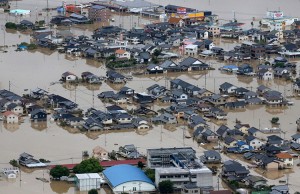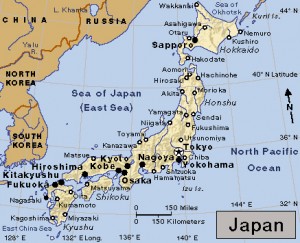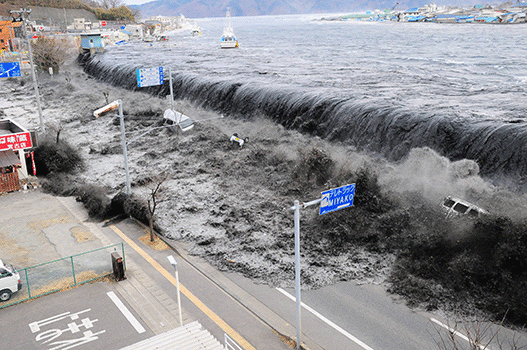Japan’s Deadly Floods
Tuesday, July 24th, 2018July 24, 2018
From the end of June through early July 2018, torrential rains intensified by Typhoon Prapiroon caused catastrophic flooding in southwestern Japan. The floods breached levees and washed out towns and roads in heavily populated areas, killing 225 people and leaving several others missing. The freshwater floods (as opposed to tsunamis and ocean-generated flooding) were the deadliest in Japan since flooding killed 299 people in Nagasaki in 1982.

Floodwaters swamp houses in the Okayama city of Kurashiki on July 8, 2018. Credit: © STR/AFP/Getty Images
Unusually heavy seasonal rains began on the island of Kyushu and nearby areas on June 28. With flooding already beginning in some prefectures, Typhoon Prapiroon dumped immense amounts of rain beginning on July 3. As the situation worsened, the Japan Meteorological Agency issued emergency alerts, prompting the evacuation of several million people. Areas of Kyushu became awash in flooding, as did parts of nearby Honshu and Shikoku islands. In Honshu, Japan’s largest and most populous island, floodwaters as high as 16 feet (5 meters) devastated the southwestern prefectures of Hiroshima and Okayama. The worst short deluge took place in Kōchi prefecture on Shikoku, where 10.4 inches (26.3 centimeters) of rain fell in just 3 hours. On July 6 and 7, the Kōchi city of Motoyama recorded 23 inches (58.4 centimeters) of rain in as many hours. The deluge continued until July 9, when the rain gave way to stifling heat that has since claimed another 70 lives.

Click to view larger image
In late June and early July 2018, flooding killed 225 people in southwestern Japan. Credit: WORLD BOOK map
Flooding and mudslides caused the most casualties in Hiroshima, where 113 people died and hundreds more were injured. At least 60 people died in Okayama where the Odagawa and Takahashi rivers burst their banks, and 26 people were killed in Ehime prefecture on Shikoku. Deaths also occurred in Fukuoka, Kōchi, Kyoto, Yamaguchi, and other prefectures. Most of the victims had ignored evacuation and other precautionary orders; several died trying to escape the floods when their vehicles were swept away. The hardest hit areas lacked appropriate levees and other flood emergency infrastructure.
More than 50,000 military and emergency personnel and thousands of volunteers responded to help people trapped by the flooding. Many roads and railways were submerged by floodwaters or blocked by debris, but boat and helicopter rescue missions ran nonstop until the floodwaters subsided and roads once again became passable. Thousands of people were rescued from the rooftops of their flooded homes.
The floods also severely damaged area crops, livestock, and wildlife. People out of immediate danger were troubled by electric power outages, commuter train stoppages, and the closure of many public and private businesses.



